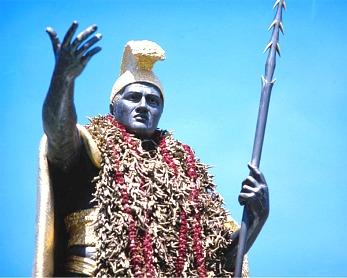

|
 The state of Hawaii (spelled Hawai'i in the Hawaiian language) is actually a chain of islands which have slowly (as in 6 million years slow) formed from volcanoes. The first settlers on the islands were Polynesians who were probably migrating from Tahiti to other Pacific Islands. Since these were volcanic islands and probably could not sustain human life, scientists feel that the original Polynesians brought coconuts, sugar cane and taro to these "new" islands for survival. In 1778, Captain James Cook arrived on the islands, and was forever written in the history books as being the first European to arrive. The native population at this time is estimated to have been between 400,000 and 800,000 people living, what many have called, an idyllic existence. In 1779, Captain Cook was killed by natives as retribution for the injustices they had suffered at the hands of Captain Cook and his crew. At about that time, Hawai'i began feeling the effects of a shifting political structure, as bloody skirmishes broke out between regional monarchs (a different king for each island) for power and control. Ultimately, over time, island rule would be consolidated under one king: King Kamehameha. In 1795 King Kamehameha, also known as Kamehameha the Great, (1758-1819) led a contingent of 1200 war canoes and 10,000 soldiers on attacks on the islands of Maui, Moloka'i and O'ahu. His enormous armada quickly broke through the scanty defenses of those islands securing them under his newly expanded monarchy. He took his role as king very seriously and took steps to protect his beloved islands, and their culture, from incursions by Europeans. Kamehameha is credited with many accomplishments, among which is a unified legal system. He also did not allow non-Hawaiians to own land (that did not changed until 1848.) By preventing Americans and Europeans from gaining property strongholds on the islands, he would insure their independence. In fact, except for one five month period of British occupation in 1843, the Kingdom of Hawai'i would remain a sovereign, and independent, nation until its annexation by the United States in 1898. Kamehameha the Great died in 1819 and was interred in an unknown tomb, in secret, by a friend. This final resting place remains a mystery to this day. The strictures he had put in place began to erode after Kamehameha’s death. In 1820, American missionaries began to arrive bringing, not only their religious beliefs, but their political and social beliefs as well, overwriting the native culture. The missionaries also taught reading and writing achieving, over the course of a few years, an impressively high literacy rate. In 1840, the first Hawai’ian Constitution was implemented under the rule of Kamehameha III thus changing rule to a constitutional monarchy as well as establishing a House of Nobles and an elected House of Representatives. Through the years, subsequent constitutions were adopted slowly decreasing the powers of the crown while increasing those of the people. The Bayonet Constitution of 1887 (so named because it had been signed under the threat of force) provided for elections to the House of Nobles, where seats were previously garnered by appointment of the King. This Constitution continued with the curtailment of royal powers in that a royal veto could be overridden by a 2/3 vote in both houses of the Legislature. It further eliminated the King’s right to veto Constitutional amendments. In 1891 Queen Liliuokalani took the throne. Shortly after her ascension she began an attempt to replace the Bayonet Constitution with a new constitution that would restore power to the monarchy. Foreseeing a loss of rights and properties, American and European subjects organized to depose the queen. John L. Stevens, the American minister to Hawaii, ordered troops from the U.S.S. Boston on to Hawaiian land to protect American interests and the Queen was deposed on January 17, 1893 and a provisional government was set in place. Later that same year, the Blount Report under the Grover Cleveland administration found that the overthrow was illegal. On November 16, 1893, it offered to give the throne back providing that Queen Liliuokalani granted amnesty to everyone responsible. She initially refused but later (on December 18, 1893) agreed to the terms. However, at that time the Provisional government refused to accept. A second Senate investigation in 1894 found no responsibility for the overthrow on the parts of either the US troops or Minister Stevens and on July 4, 1894 the Republic of Hawaii was proclaimed. Queen Liliuokalani was arrested and imprisoned for a year finally, and formally, abdicating her thrown in 1895 in exchange for the release of her supporters. She lived out her life on her beloved Hawaii which became a territory of the Untied States on July 7, 1898. With rich soils, and abundant crops of sugar cane and pineapple, Hawaii continued to grow and prosper. The bombing of Pearl Harbor on December 7, 1944 signaled the entrance of the United States into World War II, as well as an end to constitutional rights as military rule was imposed. On October 24, 1944, the U.S. Supreme Court ruled that the declaration of martial law, and trial of civilians by military courts, was invalid. However, while hysteria fueled the internment of Japanese-Americans on the mainland, those in Hawaii were spared the fate most likely because of the dependence on them for the running of plantations. On August 21, 1959, by proclamation of President Dwight David Eisenhower, Hawaii was admitted as the 50th state of the United States of America. |

|
|
||||||
|
|